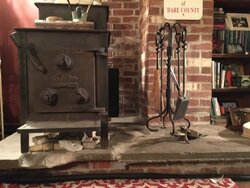You all have a very informative, positive forum and I wanted to say thank you for all of the valuable information! I apologize if I put this in the wrong forum, but it kind of involves new and old stoves. Please move if need be.
Question at hand: do we replace the old 'inefficient' stove with a newer EPA approved non-cat stove?
House history: Our farmhouse was built in 1894 and has since been remodeled by many over the years. As our primary heat today, we burn hardwood (primarily oak) in the Birmingham Stove & Range 'Ponderosa" wood stove (we have no idea how old it is which is why I did not know where to place this question). The stove is lined with firebricks, has a front loading door, and has a firebox around 3 cubic feet with a lined chimney.
After our last chimney cleaning, the guys told us we would go through far less wood if we updated the stove. They recommended a Regency cat wood stove.
As it stands, in an average MD winter, we burn 4 cords and keep the thermostat set at 55 degrees to help pick up any slack. The floors are original, the insulation is some newspaper and some upgraded Pink Panther stuff, and we just replaced all of the windows. To top it off, the house has been added to over the years, so the heat doesn't turn corners. The base of the house is 985 sq feet with the same upstairs.
After doing some research, we found good reviews on the Englander 30-NC stove (non-cat). It is a little larger at 3.5 cu ft but we have the room to accommodate it. (I want to stay away from the cat versions as we don't want the maintenance associated with it nor does it get that cold in MD to get the cat that hot that we won't be burned out of the living room.)
Englander Link: http://www.heatredefined.com/englander/stove/englander-1800-2200-sq.-ft.-wood-stove
Thoughts, opinions, experience on this is greatly appreciated
Question at hand: do we replace the old 'inefficient' stove with a newer EPA approved non-cat stove?
House history: Our farmhouse was built in 1894 and has since been remodeled by many over the years. As our primary heat today, we burn hardwood (primarily oak) in the Birmingham Stove & Range 'Ponderosa" wood stove (we have no idea how old it is which is why I did not know where to place this question). The stove is lined with firebricks, has a front loading door, and has a firebox around 3 cubic feet with a lined chimney.
After our last chimney cleaning, the guys told us we would go through far less wood if we updated the stove. They recommended a Regency cat wood stove.
As it stands, in an average MD winter, we burn 4 cords and keep the thermostat set at 55 degrees to help pick up any slack. The floors are original, the insulation is some newspaper and some upgraded Pink Panther stuff, and we just replaced all of the windows. To top it off, the house has been added to over the years, so the heat doesn't turn corners. The base of the house is 985 sq feet with the same upstairs.
After doing some research, we found good reviews on the Englander 30-NC stove (non-cat). It is a little larger at 3.5 cu ft but we have the room to accommodate it. (I want to stay away from the cat versions as we don't want the maintenance associated with it nor does it get that cold in MD to get the cat that hot that we won't be burned out of the living room.)
Englander Link: http://www.heatredefined.com/englander/stove/englander-1800-2200-sq.-ft.-wood-stove
Thoughts, opinions, experience on this is greatly appreciated



